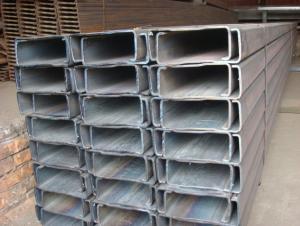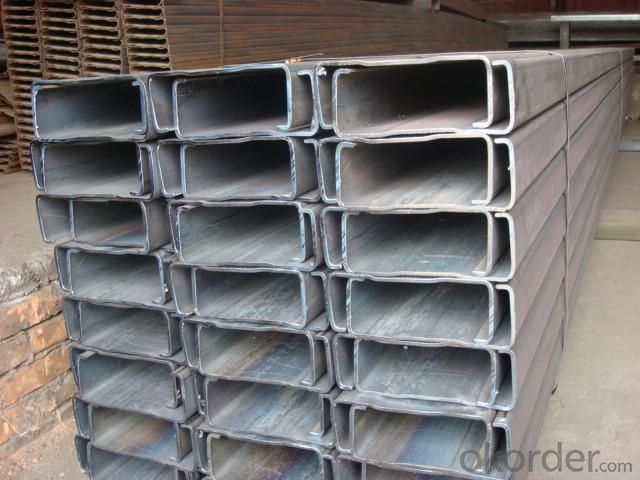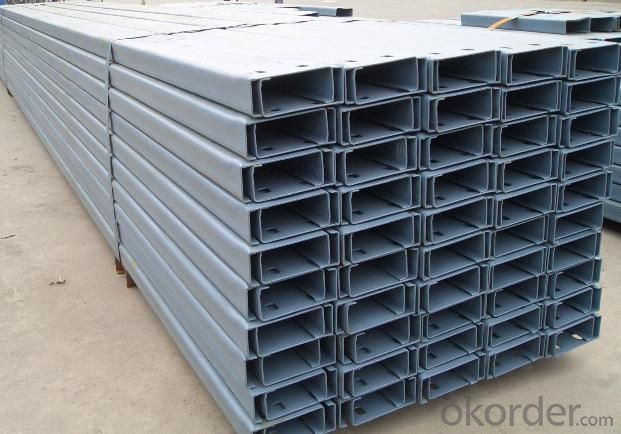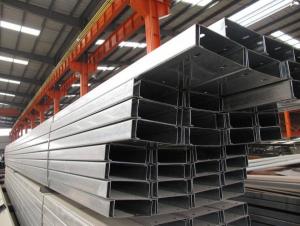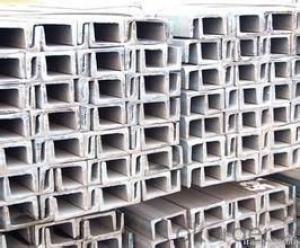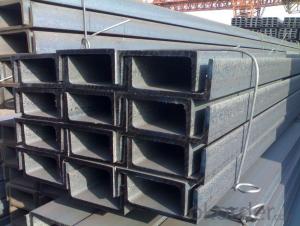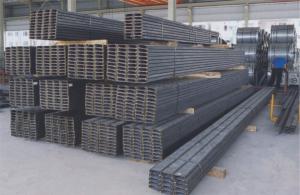Mild Carbon C Channel
- Loading Port:
- Tianjin Port,China
- Payment Terms:
- TT or LC
- Min Order Qty:
- 50MT m.t.
- Supply Capability:
- 1000 Tons Per Month m.t./month
OKorder Service Pledge
OKorder Financial Service
You Might Also Like
Specifications of Mild Carbon C Channel:
1.We supply high quality Mild Carbon C Channel at reasonable price, including Chinese standard, Japanese standard and so on.
Standard | GB/JIS/EN/ASTM/DIN |
Material Grade | Q235B,Q235,Q345,Q345B,SS400,S235JRG1,A36,ST37-2 |
Technique: | Cold Rolled |
Sizes as per chinese standard: |
80×40×20×2.5 - 180×60×20×2.5
|
Sizes as per Japanese standard: |
180×60×20×3 – 300×80×20×3 |
Length: | 6meter, 9meter, 12meter |
Note: we are also competent to provide our customers other Mild Carbon C Channel based on other sizes according to customer’s requirements.
2. The detailed sections of Mild Carbon C Channel as per GB standard.Just as followings in the table-1:
Size | Weight(kg/m) | Size | Weight(kg/m) |
80×40×20×2.5 | 3.925 | 180×60×20×3 | 8.007 |
80×40×20×3 | 4.71 | 180×70×20×2.5 | 7.065 |
100×50×20×2.5 | 4.71 | 180×70×20×3 | 8.478 |
100×50×20×3 | 5.652 | 200×50×20×2.5 | 6.673 |
120×50×20×2.5 | 5.103 | 200×50×20×3 | 8.007 |
120×50×20×3 | 6.123 | 200×60×20×2.5 | 7.065 |
120×60×20×2.5 | 5.495 | 200×60×20×3 | 8.478 |
120×60×20×3 | 6.594 | 200×70×20×2.5 | 7.458 |
120×70×20×2.5 | 5.888 | 200×70×20×3 | 8.949 |
120×70×20×3 | 7.065 | 220×60×20×2.5 | 7.4567 |
140×50×20×2.5 | 5.495 | 220×60×20×3 | 8.949 |
140×50×20×3 | 6.594 | 220×70×20×2.5 | 7.85 |
160×50×20×2.5 | 5.888 | 220×70×20×3 | 9.42 |
160×50×20×3 | 7.065 | 250×75×20×2.5 | 8.634 |
160×60×20×2.5 | 6.28 | 250×75×20×3 | 10.362 |
160×60×20×3 | 7.536 | 280×80×20×2.5 | 9.42 |
160×70×20×2.5 | 6.673 | 280×80×20×3 | 11.304 |
160×70×20×3 | 8.007 | 300×80×20×2.5 | 9.813 |
180×50×20×2.5 | 6.28 | 300×80×20×3 | 11.775 |
180×50×20×3 | 7.536 | ||
180×60×20×2.5 | 6.673 |
Table-1
3. The chemical composition of Mild Carbon C Channel according to Q235B is shown in Table-2.
Alloy No | Grade | Element(%) | ||||
C | Mn | S | P | Si | ||
Q235 | B | 0.12-0.20 | 0.3-0.7 | ≦0.045 | ≦0.045 | ≦0.3 |
Table-2
Note: we are able to present our customers relevant SGS test report for chemical composition of Mild Carbon C Channel.
4. The mechanical property of Mild Carbon C Channel according to Q235B is shown in Table-3-1 and Table-3-2
Alloy No | Grade | Yielding Strength Point(Mpa) | |||
Thickness(mm) | |||||
≦16 | >16-40 | >40-60 | >60-100 | ||
≧ | |||||
Q235 | B | 235 | 225 | 215 | 205 |
Table-3-1
Alloy No | Grade | Tensile Strength(Mpa) | Elongation After Fracture(%) | |||
Thickness(mm) | ||||||
≦16 | >16-40 | >40-60 | >60-100 | |||
≧ | ||||||
G235 | B | 375-500 | 26 | 25 | 24 | 23 |
Table-3-2
Note: we are able to present our customers relevant SGS test report for mechanical property of Mild Carbon C Channel as customer’s request.
Applications of Mild Carbon C Channel:
The Mild Carbon C Channel can be applied to construction of warehouses, workshops, sport stadiums and car parks etc.The hot rolled channel steel belongs to carbon structural steel which is applied to in the field of construction and machinery.In details, the hot rolled channel steel is usually used for arch-itechtural structure, and they could be welded in order to support or hang a vari-ety of facilities. They are also usually used in combination with I beam. Generally,the hot rolled channel steel we supply must possess perfect welding property, riveting property and mechanical property and so on.
Package & Delivery of Mild Carbon C Channel:
1.The hot rolled channel steel will be packed in bundle with steel wire at each end of every bundle and color marking in order to help the customer to recognize his goods more easily at sight.
2. And the hot rolled channel steel could be loaded into 20ft or 40ft container, or by bulk cargo.If the weight of each bundle reaches more than 3.5 mt, the loading by break bulk cargo should be choosed.When the weight of each bundle reaches less than 3mt, the loading by container should be choosed.
3.As for the transportaion from mill to loading port, the truck will be usually used. And the maximum quantity for each truck is 40mt.
4.All in all, we could do in accordance with customer's request.
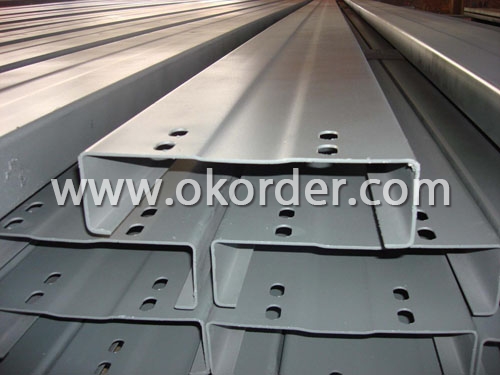
Production Flow of Mild Carbon C Channel:
1.The steel billet shall be heated in the high temperature furnace.
2. The heated steel billet shall be rolled five to nine times with the aim of shaping the general figure of steel u channel.
3. The hot rolled channel steel should be put onto the cooling bed to make the temperature low.
4. The channel steel should be straighted on the straightener.
5. The straighted channel steel will be cut into meters by saw, as per customer's requirements.
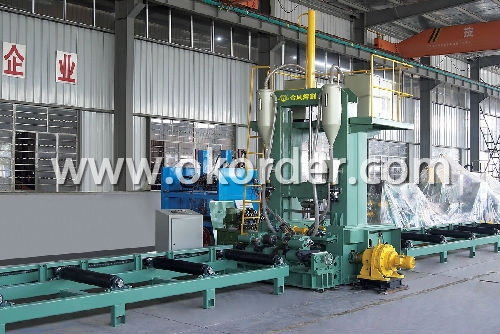
- Q: What are the different methods for surface preparation of steel channels?
- Some common methods for surface preparation of steel channels include abrasive blasting, chemical cleaning, and mechanical cleaning. Abrasive blasting involves using high-pressure air or water to propel abrasive materials against the surface of the steel channels, removing rust, scale, and other contaminants. Chemical cleaning involves using chemicals or acids to dissolve and remove rust or other surface contaminants. Mechanical cleaning involves using wire brushes, sanding, or grinding tools to physically remove rust and other surface imperfections.
- Q: Are steel channels suitable for use in HVAC systems?
- Yes, steel channels are suitable for use in HVAC systems. They are strong, durable, and resistant to corrosion, making them ideal for carrying and supporting ductwork in HVAC installations. Additionally, steel channels provide stability and structural integrity to the system, ensuring efficient airflow and proper functioning of the HVAC system.
- Q: What are the different welding methods for steel channels?
- Different welding methods can be used for steel channels depending on the application and desired outcomes. Some common methods for steel channels include: 1. Stick welding, also known as Shielded Metal Arc Welding (SMAW), involves creating an arc between an electrode coated in flux and the base metal. It is versatile and suitable for both thick and thin steel channels. 2. Gas Metal Arc Welding (GMAW), commonly referred to as MIG welding, uses a continuous wire electrode fed through a welding gun. The wire is melted and joined with the base metal while being shielded by a gas mixture. It is known for its speed and efficiency, making it ideal for high-volume production. 3. Flux-Cored Arc Welding (FCAW) is similar to GMAW but uses a flux-filled tubular wire instead of a shielding gas. The flux creates a protective shield around the weld and is useful for outdoor applications or environments with strong drafts. 4. Gas Tungsten Arc Welding (GTAW), also known as TIG welding, uses a non-consumable tungsten electrode to heat the base metal. A separate filler rod is manually fed into the weld pool, providing precision and control for thin steel channels or high-quality welds. 5. Submerged Arc Welding (SAW) involves feeding a continuous wire electrode into the joint while a layer of granular flux covers the weld zone. The arc is submerged beneath the flux, providing protection. This method is commonly used for thicker steel channels or high deposition rates. When selecting a welding method, it is important to consider the specific requirements of the steel channel and the intended application. Each method has its own advantages and limitations, so choosing the most appropriate method is crucial for achieving desired results in terms of strength, aesthetics, and efficiency.
- Q: What are the deflection limits for steel channels?
- The deflection limits for steel channels can vary depending on several factors such as the type of steel, the size and shape of the channel, and the intended application. However, there are generally accepted deflection limits set by engineering standards and codes that are followed in the industry. In most cases, the deflection limits for steel channels are determined based on the maximum allowable deflection to ensure the structural integrity and functionality of the channel. The deflection limit is typically expressed as a ratio of the channel's span length to its depth. For example, the American Institute of Steel Construction (AISC) provides guidelines for deflection limits in their specification. According to AISC, the recommended deflection limit for simply supported steel channels is L/300, where L represents the span length of the channel. This means that the deflection of the channel should not exceed one-thirtieth of the span length. It is important to note that these deflection limits may vary for different types of steel channels, such as those used in heavy-duty applications or those subjected to dynamic loads. In such cases, more stringent deflection limits may be specified to ensure the channel can withstand the intended loads without significant deformation. It is also worth mentioning that deflection limits should be considered in conjunction with other design factors such as strength, stability, and serviceability requirements. The overall design of the steel channel should take into account these factors to ensure a safe and reliable structure. To determine the specific deflection limits for a particular steel channel, it is recommended to consult the relevant design codes and standards, as well as seek the advice of a professional structural engineer who can provide accurate and specific guidance based on the project requirements.
- Q: How do steel channels perform in high-temperature industrial applications?
- Steel channels are widely used in high-temperature industrial applications due to their excellent performance capabilities. One of the key advantages of steel channels in such environments is their high heat resistance. Steel, being a highly durable and heat-resistant material, can withstand extreme temperatures without deformation or degradation. In high-temperature industrial applications, steel channels perform exceptionally well due to their ability to retain their structural integrity, even under constant exposure to elevated temperatures. They can withstand thermal expansion and contraction without warping or bending, ensuring the stability and reliability of the structures they are used in. Moreover, steel channels have excellent corrosion resistance, which is crucial in high-temperature environments where chemicals and gases may be present. The corrosion resistance of steel channels prevents them from deteriorating, even when exposed to aggressive substances, ensuring their longevity and minimizing maintenance requirements. Steel channels also offer high strength and load-bearing capacity, making them suitable for heavy-duty applications in industries such as manufacturing, construction, and oil and gas. Their robustness allows them to support heavy loads and withstand the demands of high-temperature environments without compromising their structural integrity. Furthermore, steel channels are versatile and can be easily customized to meet specific requirements. They come in various sizes, shapes, and thicknesses, allowing for greater flexibility in designing structures for high-temperature industrial applications. This adaptability makes steel channels a preferred choice for engineers and designers working in such industries. In summary, steel channels perform exceptionally well in high-temperature industrial applications. Their heat resistance, corrosion resistance, strength, and versatility make them reliable and durable components for structures exposed to extreme temperatures. Whether it is in furnaces, boilers, or other industrial settings, steel channels provide the necessary stability and functionality required for safe and efficient operations in high-temperature environments.
- Q: Small Huxing, suitable for what modeling ceiling, channel across 4.8 meters, 60cm file, middle angle steel, 60cm first gear, what kind of modeling ceiling?
- Channel steel in the laying of must have specifications, that is, there are spacing, such as the lattice of 60cm*60cm; in this case, the most direct is to do lattice ceiling, it is up to the concave shape of the lattice;
- Q: What are the guidelines for steel channel installations in corrosive environments?
- The guidelines for steel channel installations in corrosive environments include using corrosion-resistant materials such as stainless steel or galvanized steel, ensuring proper drainage to prevent water accumulation, applying protective coatings or paints to the steel channels, regularly inspecting and maintaining the channels for any signs of corrosion, and following industry standards and recommendations for installation and maintenance procedures.
- Q: What are the different design codes and standards for steel channels?
- Steel channels are subject to numerous design codes and standards that ensure their structural integrity and safety. The American Institute of Steel Construction (AISC) Specification for Structural Steel Buildings is a well-known code that offers comprehensive guidelines for the design, detailing, and construction of steel structures, including channels. It covers various topics like permissible stress design, load combinations, and connection design requirements. Apart from the AISC Specification, there are other applicable design codes and standards for steel channels, depending on their specific use. For example, the American Society of Civil Engineers (ASCE) 7-16 Minimum Design Loads and Associated Criteria for Buildings and Other Structures provides guidelines for determining design loads, which are crucial in channel design. The ASTM A36/A36M specification is another pertinent standard that outlines the requirements for carbon structural steel, including channels. It encompasses chemical composition, mechanical properties, and other specifications for carbon steel materials. Furthermore, the International Building Code (IBC) is a widely adopted and enforced model code in many countries. It includes provisions for the design and construction of steel structures, ensuring compliance with safety and performance requirements. It is important to acknowledge that design codes and standards can vary depending on the country or region. Therefore, consulting the relevant local codes and standards is essential when designing and constructing steel channels. Overall, these diverse design codes and standards provide engineers and designers with the necessary guidelines and requirements to ensure the safe and efficient design of steel channel structures. They cover various aspects, such as load calculations, material specifications, design methodologies, and construction practices, all aimed at ensuring the structural integrity and safety of steel channels.
- Q: What's the size of channel 16, please? Thank you!
- 16# channel steel GB, A, B two kinds: 16#A trough, 16#B trough said. Specific specifications are: 16#A:, 160*63**6.5 adjustment, rice weighing 17.24KG, 16#B:160*65*8.5 adjustment, rice weighing 19.752KG
- Q: Are steel channels suitable for use in the construction of rooftop structures?
- Yes, steel channels are suitable for use in the construction of rooftop structures. Steel channels are known for their strength and durability, making them an excellent choice for supporting the weight of rooftop structures. They can withstand heavy loads and provide stability and structural integrity to the construction. Steel channels are also resistant to weather elements, such as rain, wind, and snow, which are common on rooftops. Moreover, steel channels can be easily fabricated and installed, making them a cost-effective and efficient option for rooftop construction. Overall, steel channels offer numerous advantages, making them a suitable choice for use in the construction of rooftop structures.
1. Manufacturer Overview
| Location | Tianjin,China |
| Year Established | 2006 |
| Annual Output Value | Above US$ 500 Million |
| Main Markets | China; Middle East; Southeast Asia; South America |
| Company Certifications |
2. Manufacturer Certificates
| a) Certification Name | |
| Range | |
| Reference | |
| Validity Period |
3. Manufacturer Capability
| a) Trade Capacity | |
| Nearest Port | Tianjin |
| Export Percentage | 40%-60% |
| No.of Employees in Trade Department | 11-20 People |
| Language Spoken: | English; Chinese |
| b) Factory Information | |
| Factory Size: | Above 50,000 square meters |
| No. of Production Lines | Above 3 |
| Contract Manufacturing | materials for processing; OEM Service Offered |
| Product Price Range | Average |
Send your message to us
Mild Carbon C Channel
- Loading Port:
- Tianjin Port,China
- Payment Terms:
- TT or LC
- Min Order Qty:
- 50MT m.t.
- Supply Capability:
- 1000 Tons Per Month m.t./month
OKorder Service Pledge
OKorder Financial Service
Similar products
Hot products
Hot Searches
Related keywords
